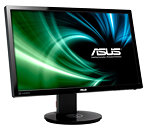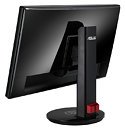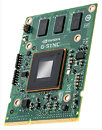Saturday, October 19th 2013

ASUS Announces Adoption of NVIDIA G-SYNC Technology
ASUS is excited to announce that it will adopt NVIDIA G-SYNC technology into its next generation monitor lineup. NVIDIA G-SYNC, a significant innovation in display technology, provides an excellent gaming experience and stunning visual quality by synchronizing the monitor's refresh rate to the GPU's render rate. Images are displayed the moment they are rendered, which results in smoother gameplay and sharper images through the elimination of onscreen tearing, stuttering, and latency.
G-SYNC technology includes an NVIDIA G-SYNC module that requires integration into monitors, as well as hardware and software incorporated into its Kepler-based GPUs. It removes the need to use older technologies such as V-Sync, which can eliminate tearing but can increase latency and stuttering during gameplay. G-SYNC eliminates this trade-off leading to an uncompromised PC gaming experience.ASUS, in a joint effort with NVIDIA, has been working over the past year to bring G-SYNC technology to market and will incorporate it into new monitors beginning in 2014. ASUS plans to release a G-SYNC-enhanced VG248QE gaming monitor in the first half of 2014 with pricing set at $399 USD in North America.
"ASUS strives to provide the best possible gaming experience by being at the forefront of technology and innovation. We are excited to be first to support and embrace NVIDIA's new G-SYSNC technology in upcoming ASUS gaming monitors. Gamers are certain to be impressed with its incredible step-up in smoothness and visual quality." said Vincent Chou, Associate Vice President of Display Business Unit ASUSTek.
G-SYNC technology includes an NVIDIA G-SYNC module that requires integration into monitors, as well as hardware and software incorporated into its Kepler-based GPUs. It removes the need to use older technologies such as V-Sync, which can eliminate tearing but can increase latency and stuttering during gameplay. G-SYNC eliminates this trade-off leading to an uncompromised PC gaming experience.ASUS, in a joint effort with NVIDIA, has been working over the past year to bring G-SYNC technology to market and will incorporate it into new monitors beginning in 2014. ASUS plans to release a G-SYNC-enhanced VG248QE gaming monitor in the first half of 2014 with pricing set at $399 USD in North America.
"ASUS strives to provide the best possible gaming experience by being at the forefront of technology and innovation. We are excited to be first to support and embrace NVIDIA's new G-SYSNC technology in upcoming ASUS gaming monitors. Gamers are certain to be impressed with its incredible step-up in smoothness and visual quality." said Vincent Chou, Associate Vice President of Display Business Unit ASUSTek.



66 Comments on ASUS Announces Adoption of NVIDIA G-SYNC Technology
amd do lock out lower cards but not before 3 years typically ,
nvidia try all that they can to keep there fans buying new green stuff my mates a doosie for green I am too just a diff type,
hes already got an nvidia 3d monitor he bought two years ago for Way over the odds and even he isn't daft enough to just keep buying this stuff ,, well I think.
I like how nv are working on making slow shit look good though wtf and I watched two hrs of three sellouts waffling absolute ass smoke to an nv rep to be able to say seriously,,,
this is only selling to fans and the geek elite with mega doe, because at 1080p where most of the Western world games at, this isn't selling , a bit like shield I mean any sane guy would just buy a better phone but a fan aahh.
Amd have also done some Good work lately on a new type of display Standard (open unlicensed) to identify and tile correctly 4k+ screens afaik visa id based thats how They role.
I assume Nvidia are evil and AMD are awesome, but beyond that... no clue.
But damn, lay off the drugs and for the love of God, try to form a decent sentence at least once in your life.
If this monitor had a thinner bezel I would seriously consider it for an upgrade.
On topic though I'm not sure you know what you're on about. The thing is pratically no one has seen this tech irl, and I assume that is the thing you have to do to understand it. When you've seen it, then you can pass judgement.
Personally I find the issues that necessitate V-Sync and issues with V-Sync itself mildly annoying. Anything that will abate these issues would be welcome IMO but not necessarily invaluable. Additional hardware tech that amounts to a definitive gamer oriented products such as G-Sync compliant monitors IMO is additive. Clearly such products will be more expensive and limited in scope (nVidia proprietary, lower resolution, ect).
I think there is room in the market for G-Sync though. The fact that it is proprietary rather then an industry standard doesn't bother me. What bothers me is that the industry didn't address the issue with an industry standard to correct these afflictions years ago, which, is what necessitates the proprietary solution in the first place.
There was some talk that in the future there may be monitors that you can simply add a G-Sync module to.
I often switch between nVidia and AMD/(ATI) so for example I went from an HD 6870 to a GTX670. People who do this know that they lose or gain proprietary features exclusive to their hardware choices. So having a monitor with G-Sync and a video card that doesn't support it for a generation or two of GPU isn't really a big deal to me.
Having said that, my next monitor will likely be a 4K display so nuts to this :)
I'm not saying for AMD, Nvidia and Intel to share CPU/GPU designs, but to develop and share software technology that works across the board, maybe flag Valve down to help reign in the OpenAPI's.
Unfortunately, this is what happens with open standards bodies; not just for NVidia or AMD but for all big companies. Big companies join open standards bodies with their own agendas instead of open minds. If they don't like what the open standards body advocates then they leave and use their power to develop competing, proprietary technology that undermines the open standard and fractures the market instead of unifying it.
Closed standards bodies that sell licenses to their standards are the best way to ensure compliance. It does require royalties to be paid, but it also ensures that there is a consistent vision and a strong backer of the standard. Good examples of these closed standards working in the computer field are DirectX and HDMI.